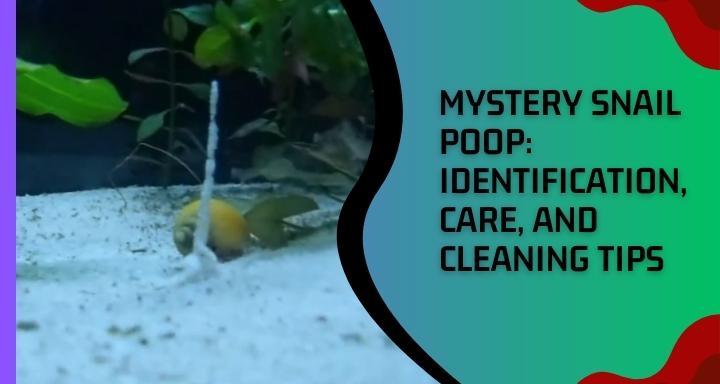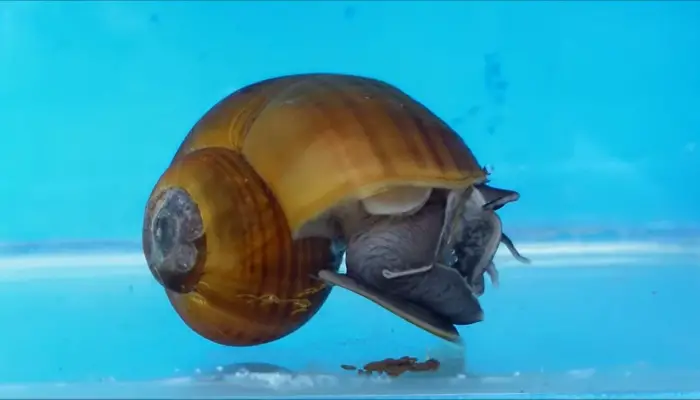
Yesterday, one of my friends came to me and said, “Mystery snail has white poop.” At first, I couldn’t catch his words. Then, he described me in detail and I understood what his problem was.
Not only that, but I also used to face such types of problems regularly during the first phase of my aquarium activity. I was even confused between mystery snail eggs and poops. Though I had an aquarium specialist friend and I used to take suggestions from him, luckily my close observation power cleared a lot of things for me.
For some days, I was getting requests for updating such topics on my website and that’s why I am here to suggest to you about mystery snail poop.
What Does Snail Poop Look Like?
Before further discussion, I think I should describe what snail poop looks like. so that you can match it with yours. When I first saw poops in my aquarium, I was completely confused as to what it was! But then I learned from one of my friends that the small, brown, or black-colored thing that I found in my aquarium was snail poop.
Still now, sometimes I find poop in my fish tank. It can vary in shape depending on the type of snail, but it is generally cylindrical or pellet-shaped. Snail poop may also contain small bits of undigested food, which can give it a speckled appearance.
Here, you can get a more clear and more visual conception of mystery snail poop.
Mystery Snail Poop vs Eggs

Sometimes, I find that people get confused between mystery snail poops and eggs though they are completely two different things and can be easily distinguished from each other. Well, if you also have such problems you can have a glance at my terms-
Appearance
Firstly, you should notice their appearance. Mystery snail poop is small, cylindrical. They are usually brown or dark green. It can be found in small clusters or individual pellets.
On the other hand, mystery snail eggs are round, white, and translucent. They are often found in clusters attached to a solid surface like the glass walls of a fish tank.
Location
Mystery snail poop can be found anywhere in the tank where the snail has been, including on the substrate, decorations, and plants.
Mystery snail eggs, on the other hand, are usually laid above the water line and attached to solid surfaces like the glass walls of the tank or the underside of a leaf.
Quantity
Mystery snail poop is produced regularly and in small amounts, whereas mystery snail eggs are laid in large clusters and usually only once every few weeks.
If you’re still not sure whether what you’re looking at is mystery snail poop or eggs, you can consult a veterinarian or an experienced aquarium hobbyist for assistance.
Why Does My Mystery Snail Poop Too Much?

Mystery snails are known to produce a significant amount of waste and the frequency of their excretion can depend on several factors such as their diet, water conditions, and overall health.
One reason your mystery snail may be pooping more than usual is that it’s overeating. If you’re feeding your snail more than it needs or if it’s eating food scraps and other organic matter in the tank, it may be producing more waste than normal. It’s important to ensure that you’re not overfeeding your snail and that it has a balanced diet.
Water quality can also impact the frequency of your mystery snail’s excretion. Poor water quality can lead to stress, illness, and increased waste production. Regularly monitor and maintain proper water parameters such as pH, temperature, ammonia, and nitrite levels.
Lastly, if your snail has recently changed environment or if it’s showing signs of illness such as lethargy, loss of appetite, or discoloration, it may be producing more waste than normal. In this case, monitoring your snail’s behavior closely and seeking veterinary assistance if necessary is important.
Overall, mystery snails are known to produce a lot of waste, so it’s important to ensure that you’re maintaining proper water conditions and feeding your snail a balanced diet to minimize excess waste production.
How to Get Rid of Snail Poops in an Aquarium
Snail poop can be unsightly and can negatively affect the water quality in your aquarium. Hence, if you want to get rid of mystery snail poop, get ideas to get rid of it from below-
Perform Regular Water Changes
Regular water changes are crucial for maintaining good water quality in your aquarium. You should aim to change about 10-20% of the water in your tank every week.
Increase Filtration
Adding additional filtration to your aquarium can help remove snail poop and other debris from the water.
Use a Gravel Vacuum
A gravel vacuum is a tool that can be used to suck up debris from the bottom of your aquarium. This can help remove snail poop and other waste from your tank.
Reduce Feeding
Overfeeding your fish and snails can lead to an excess of waste in the tank. Try reducing the amount of food you feed your aquatic pets to prevent an excessive build-up of snail poop.
Manual Removal
If you notice a significant amount of snail poop in your aquarium, you can manually remove it using a fishnet or a siphon. Simply scoop or suck up the poop from the tank.
Remember, maintaining good water quality is key to a healthy aquarium environment. Regular maintenance and cleaning can help prevent a build-up of snail poop and other waste in your tank.
How to Clean Mystery Snail Poop
Cleaning up mystery snail poop is a relatively simple process. Here are the steps-
Gather your Cleaning Supplies
You will need a small aquarium net, a siphon vacuum or gravel cleaner, a bucket, and a water conditioner.
Remove Any Uneaten Food
Before you begin cleaning the poop, remove any uneaten food from the tank. This will help prevent further buildup of waste in the tank.
Use the Net to Scoop Out Any Visible Poop
Use the aquarium net to remove any visible poop floating on the surface of the water.
Use the Siphon Vacuum to Clean the Substrate
Place the siphon vacuum or gravel cleaner at the bottom of the tank, and start the siphoning process. Move the vacuum around to collect any poop or waste that has settled on the substrate. Be sure to focus on the areas where your snails spend the most time.
Replace the Water
Once you have removed as much poop as possible, replace the water in the tank. Be sure to use a water conditioner to remove any chlorine or other chemicals from the tap water.
Repeat as Needed
Depending on the size of your tank and the number of snails you have, you may need to clean the poop out of the tank once or twice a week to keep the water clean and healthy for your snails.
By following these steps, you can keep your mystery snail’s tank clean and healthy for them to thrive in.
Is Snail Poop Dangerous for Aquarium?
In general, snail poop is not dangerous to have in an aquarium. Snails can be a beneficial addition to an aquarium ecosystem, as they can help clean up excess food and other waste materials and can also help to aerate the substrate.
That being said, if there is an excessive amount of snail poop in the aquarium, it could potentially contribute to poor water quality and harmful levels of ammonia and nitrates. This is because snail poop, like any organic material, can break down and release harmful chemicals as it decomposes.
To prevent this from happening, it is important to maintain proper filtration and water changes in the aquarium and the ways that I explained before.
Is Mystery Snail Poop Good For Plants?
Mystery snail poop, like any other type of aquarium snail poop, contains nutrients that can benefit plants in the aquarium. Snail waste contains nitrogen, phosphorus, and potassium, which are essential macronutrients for plant growth.
In a nutshell, in small amounts, mystery snail poop can be beneficial for plants in the aquarium, but it is important to maintain proper water parameters and keep the snail population in check to prevent any negative effects on the aquarium ecosystem.
What Eats Snail Poop?
Snail poop, or snail feces, consists mainly of undigested plant material and other waste products. In an aquarium, several organisms can help consume snail poop, including certain species of fish, snails, shrimp, and other invertebrates.
Some fish species that are known to eat snail poop include Corydoras catfish, Otocinclus catfish, and Plecostomus catfish. Snails, such as Nerite snails, Mystery snails, and Ramshorn snails, can also help consume snail poop.
Additionally, freshwater shrimp, such as Cherry shrimp and Amano shrimp, can also be effective in keeping the aquarium clean by eating waste materials.
It’s important to note that while these organisms can help consume snail poop, they cannot entirely replace proper aquarium maintenance, such as regular water changes and cleaning the aquarium substrate.
Apart from those, if you want to talk about other outside species, dung beetles are known to feed on snail feces, as well as on the feces of other animals. Some species of birds, such as thrushes, also eat snail poop, as do some small mammals, such as shrews and mice.
FAQs
How Often Do Mystery Snails Poop?
Mystery snails typically poop once or twice a day, but this can vary depending on the individual snail’s diet and activity level in your aquarium.
What Causes Excessive Mystery Snail Poop?
Excessive mystery snail poop can be caused by overfeeding or a diet that is too high in protein. If you notice your snail is producing an excessive amount of poop, try adjusting their diet and feeding them smaller amounts more frequently.
Can Mystery Snail Poop Indicate A Health Problem?
Mystery snail poop can be an indicator of a health problem if it is discolored or has an unusual texture. If you notice any changes in your snail’s poop, along with other symptoms such as lethargy or loss of appetite, it may be a sign of illness and you should consult a veterinarian or aquatic specialist
Final Words
So, this is the last phase of my detailed description. In my long aquarium experience, I met with mystery snail long poop and Mystery Snail stringy poop. Also, I found bladder snail poop. Besides, sometimes I found that mystery snails eat fish poop. Well, I love to explore these new things.
And, whenever I find any new material in my aquarium, I try to research a lot about them and try to find the solution to solve them. Luckily, the solutions that I made were perfect for me. Hopefully, you will also get enough information from my experiences.
- Top 15 Freshwater Aquarium Plant Ideas for a Lush, Green Tank - November 9, 2024
- Top 13 Freshwater Aquarium Layout Ideas for a Beautifully Organized Tank - November 9, 2024
- 14 Stunning Rustic Freshwater Aquarium Ideas for a Tranquil Environment - November 9, 2024
